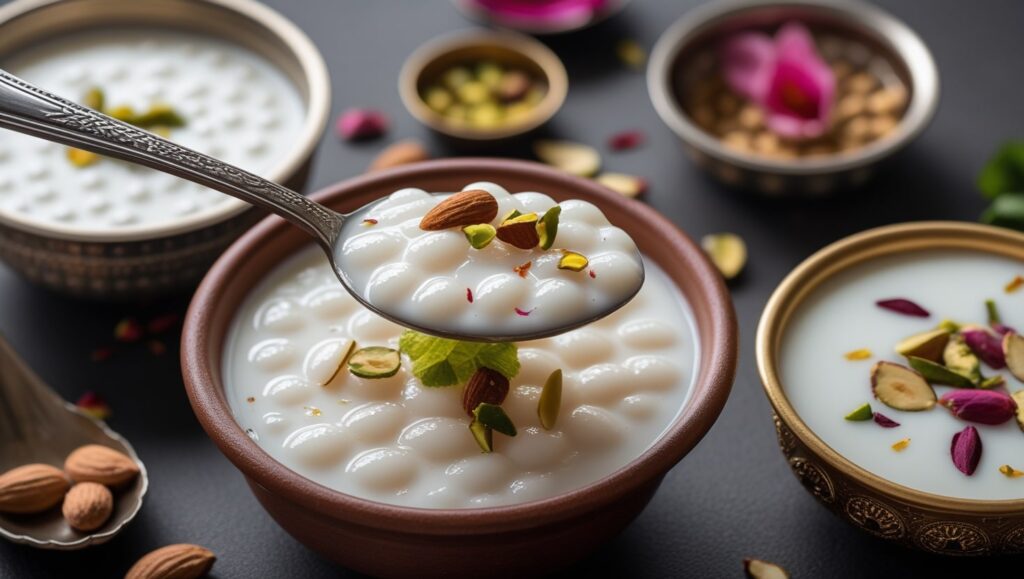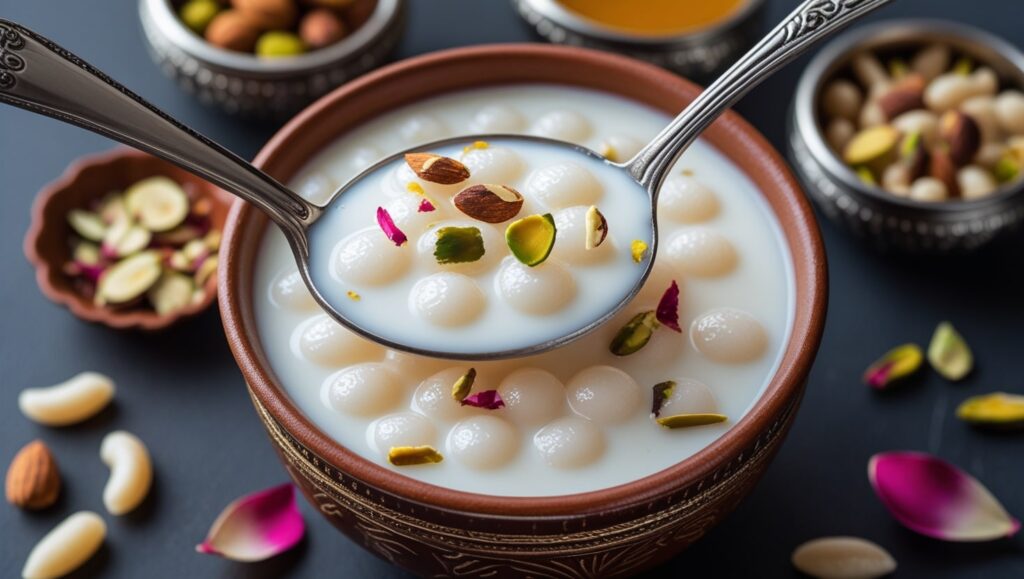One of the most popular desserts in India is kheer, a rice pudding that is creamy and fragrant. But have you ever tried Moriyo Kheer? This unique variation replaces rice with moriyo (sago pearls or sabudana), resulting in a lighter yet equally indulgent treat. Perfect for festive occasions, fasting days (like Navratri or Ekadashi), or just a sweet craving, this dessert is both easy to make and deeply satisfying.
In this article, we’ll explore:
- What makes moriyo kheer special
- A step-by-step recipe with expert tips
- Common mistakes to avoid
- Variations to suit different tastes
By the end, you’ll be ready to whip up a bowl of this delightful dessert like a pro!
What is Moriayo Kheer?
Moriyo (or sabudana) kheer is a traditional Indian pudding made with sago pearls, milk, sugar, and aromatic spices like cardamom. Unlike rice kheer, which has a thicker texture, moriyo kheer recipe has a delicate, slightly chewy consistency. It’s often enjoyed during religious fasts because sabudana is considered a light, energy-boosting ingredient.

Why You’ll Love This Recipe
✅ Light & Digestible – Great for when you want something sweet but not too heavy.
✅ Quick to Make – Unlike rice kheer, which requires slow cooking, sago cooks faster.
✅ Versatile – Can be customized with nuts, fruits, or even coconut milk for a vegan version.
Step-by-Step Moriayo Kheer Recipe
Ingredients (Serves 4)
- ½ cup sabudana (sago pearls)
- 4 cups whole milk (for richness; can use low-fat for a lighter version)
- ½ cup sugar (adjust to taste)
- 4-5 green cardamom pods (crushed)
- A pinch of saffron (optional, for aroma)
- 2 tbsp chopped nuts (cashews, almonds, pistachios)
- 1 tbsp ghee (clarified butter)
- 1 tsp rose water (optional, for fragrance)
Method
1. Prep the Sabudana
- Use cold water to rinse the sabudana until the water runs clean.
- Soak in 1 cup of water for 30 minutes. This softens the pearls, reducing cooking time.
2. Cook the Sabudana
- Drain the soaked sabudana.
- In a heavy-bottomed skillet, heat 1 tablespoon of ghee and roast the nuts slowly until they become brown.
- In the same pan, add the drained sabudana and sauté for 2 minutes.
3. Simmer with Milk
- Pour in the milk and stir well.
- To avoid sticking, cook over medium heat, stirring occasionally.
- After 10-12 minutes, the sabudana will turn translucent, and the mixture will thicken slightly.
4. Sweeten & Flavor
- Add sugar, cardamom, and saffron. Stir until the sugar dissolves.
- Cook for another 5 minutes until the kheer reaches a creamy consistency.
5. Final Touches
- Turn off the heat and add the toasted nuts.
- For extra fragrance, add rose water.
- Serve warm or chilled, garnished with more nuts or dried rose petals.
Expert Tips for the Perfect Moriayo Kheer
✔ Soaking is Key – If you skip soaking, the sabudana may remain hard in the center.
✔ Stir Frequently – Prevents the milk from burning at the bottom.
✔ Adjust Sweetness – Some prefer jaggery instead of sugar for a deeper flavor.
✔ Texture Control – For a thicker kheer, cook longer; for a lighter one, add more milk.

Common Mistakes to Avoid
❌ Overcooking Sabudana – It can turn mushy. Stop when pearls are soft but still hold shape.
❌ Using High Heat – Milk can curdle; always cook on low-medium flame.
❌ Skipping the Roasting Step – Lightly frying sabudana in ghee enhances flavor.
Variations to Try
Vegan Moriayo Kheer: Swap out dairy and sugar for coconut milk and jaggery.
Fruity Twist – Add mashed bananas or mango puree for natural sweetness.
Nutty Delight – Swap regular nuts for chironji (charoli seeds) for a traditional touch.

Conclusion
Moriyo kheer is a delightful alternative to traditional rice kheer, offering a lighter texture with the same comforting sweetness. Whether you’re observing a fast or simply craving a creamy dessert, this recipe is a winner. With the right technique—proper soaking, gentle cooking, and balanced flavors—you’ll master it in no time.

Moriyo Kheer Recipe
Equipment
- 1. Cooking Pot
- 2. Soaking Bowl
- 3. Strainer
- 4. Measuring Tools
- 5. Stirring Utensil
Ingredients
- ½ cup sabudana (sago pearls)
- 4 cups whole milk (for richness; can use low-fat for a lighter version)
- ½ cup sugar (adjust to taste)
- 4-5 green cardamom pods (crushed)
- A pinch of saffron (optional, for aroma)
- 2 tbsp chopped nuts (cashews, almonds, pistachios)
- 1 tbsp ghee (clarified butter)
- 1 tsp rose water (optional, for fragrance)
Instructions
1. Prep the Sabudana
- Use cold water to rinse the sabudana until the water runs clean.
- Soak in 1 cup of water for 30 minutes. This softens the pearls, reducing cooking time.
2. Cook the Sabudana
- Drain the soaked sabudana.
- In a heavy-bottomed skillet, heat 1 tablespoon of ghee and roast the nuts slowly until they become brown.
- In the same pan, add the drained sabudana and sauté for 2 minutes.
3. Simmer with Milk
- Pour in the milk and stir well.
- To avoid sticking, cook over medium heat, stirring occasionally.
- After 10-12 minutes, the sabudana will turn translucent, and the mixture will thicken slightly.
4. Sweeten & Flavor
- Add sugar, cardamom, and saffron. Stir until the sugar dissolves.
- Cook for another 5 minutes until the kheer reaches a creamy consistency.
5. Final Touches
- Turn off the heat and add the toasted nuts.
- For extra fragrance, add rose water.
- Serve warm or chilled, garnished with more nuts or dried rose petals.
OUR MORE DELICIOUS RECIPES
Frequently Asked Questions
1. Can I make moriyo kheer without dairy?
Yes! For a vegan version:
Replace dairy milk with coconut milk (for richness) or almond milk (lighter option).
Use maple syrup or jaggery instead of sugar.
Pro Tip: Coconut milk pairs perfectly with sago’s texture.
2. Why is my sabudana still hard after cooking?
This usually happens when:
You didn’t soak it long enough (30 mins minimum).
Cooked on high heat (sago needs gentle simmering).
Used old/bad-quality sabudana (always buy fresh).
Fix: Add warm milk and cook longer on low heat.
3. How long does it last in the fridge?
3 days in an airtight container.
The texture thickens over time—loosen with warm milk before serving.
Do not freeze (sago turns rubbery).
4. Can I use jaggery instead of sugar?
Absolutely! Jaggery adds a caramel-like depth:
Add it after cooking sabudana (to prevent graininess).
Strain if using crumbly jaggery to remove impurities.
Balance flavors with extra cardamom (jaggery can dominate).










